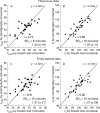A valid, accurate, office based non-radioactive test for gastric emptying of solids
- PMID: 10807886
- PMCID: PMC1756454
- DOI: 10.1136/gut.46.6.768
A valid, accurate, office based non-radioactive test for gastric emptying of solids
Abstract
Background: Current breath tests for measurement of gastric emptying of solids are expensive, possibly inaccurate, and require cumbersome calculations.
Aims: We wished to validate a simplified solid gastric emptying test using a [(13)C]Spirulina platensis breath test for accurate results relative to scintigraphy.
Subjects: Thirty healthy volunteers.
Methods: We measured gastric emptying of egg containing [(13)C]S platensis and (99m)Tc sulphur colloid by breath (13)CO(2) and scintigraphy over six hours. A generalised linear regression model was used to predict t(1/2) and t(LAG) by scintigraphy from breath (13)CO(2) data. The model was cross validated and normative data calculated for a prepacked [(13)C]meal.
Results: Regression models using all breath data over six hours, for the first three hours, and for samples at 75, 90, and 180 minutes ("reduced model") predicted t(1/2) and t(LAG) values similar to scintigraphy (t(LAG) 43 (SD 12) min; t(1/2) 100 (20) min). Standard deviations of differences in t(1/2) and t(LAG) between scintigraphy and the "reduced model" were both 10 minutes. Gastric t(1/2) for the prepacked [(13)C]meal was 91 (15) min (10-90% range: 74-118).
Conclusion: The [(13)C]S platensis breath test and a simple formula using breath (13)CO(2) at baseline, 90, and 180 minutes measured gastric emptying t(1/2) for solids with results that were comparable with scintigraphy.
Figures




References
Publication types
MeSH terms
Substances
Grants and funding
LinkOut - more resources
Full Text Sources
Other Literature Sources
